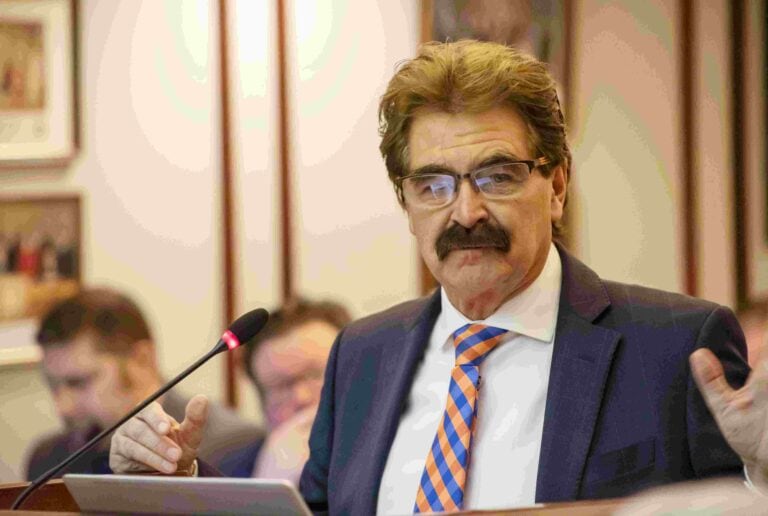Dr. William Brown is a professor of neurology at McMaster University and co-founder of the Infohealth series at the Niagara-on-the-Lake Public Library.
Dr. William Brown
Special to The Lake Report
The news on the vaccine front in late 2020 was hope at last – hope that we could finally put COVID-19 behind us in 2021 and the sooner the better.
The first three vaccines look very promising. The efficacy rates for Pfizer-BioNTech’s vaccine and the Moderna vaccine created by Massachusetts Technology working with the U.S. Institute of Allergy and Infectious Diseases, exceed 90 per cent, including clients 65 years of age and older.
Oxford-AstraZeneca’s vaccine was less impressive: the efficacy rate ranged from 60 to 90 per cent, depending on how the data was analyzed and unlike the other two, this vaccine may be less effective for those over age 65. The logistics for distributing these vaccines range from relatively easy to challenging.
Here Oxford’s vaccine wins out: it can be safely stored in ordinary refrigerators unlike the minus-20 C required for the Moderna vaccine, and the frigid minus-70 C mandated for Pfizer’s vaccine. The ease of handling and distributing the Oxford vaccine coupled with its lower price, has made it the best choice for poorer, less well-resourced countries, charitable organizations and the WHO as well as the U.K. and India.
Fortunately, there are other vaccines in the pipeline which are designed to target different viral proteins and thus offer potential backups should the immunological protection conferred by the current crop prove too short in duration or the virus manages to mutate itself around the current vaccine targets.
The major challenge is not manufacturing enough of the vaccines but getting the vaccines to those most in need as quickly as possible. First off should be those working in emergency rooms and intensive care units who are charged directly and indirectly with caring for patients with COVID-19 and I would argue, residents and staff in long-term care facilities. After all, that’s where most of the dying takes place in this pandemic.
Thereafter should follow those 65 and over and all with comorbid conditions. Finally, last in line, the young and healthy. But rolling out vaccines on a massive scale is no easy challenge, as the U.S. and Canada are finding out, what with bureaucratic boondoggles and shortages of trained staff.
The goals of such an ambitious program are twofold: to protect those vaccinated from the disease and to quickly immunize enough of the population to stop the spread of the virus.
Dr. Anthony Fauci suggests that vaccination of 80 per cent or more of the population is necessary to block the spread of the virus – the so-called herd effect.
If so, I’m worried because so many, including some within the health care system, are wary of taking the vaccine because of misleading information spread by social media and in some instances, politicians more concerned with their image than looking after the welfare of the public.
That and my concern about the efficiency of governments and the health care system in getting the vaccine to those in need quickly and in sufficient numbers to harness the herd effect, are my chief worries – and should be yours.
We know we’re in deep trouble when case numbers continue to rise and intensive care units are overloaded. That situation is made worse now by the fact many staff in emergency rooms and intensive care units are at the end of their physical and mental ropes, given the escalating demands to manage more patients while continuing to provide humane care.
In the Second World War, combat fatigue often rendered front-line units unfit for action within 100 days or less, depending on the intensity of the combat, the toll in dead and wounded and unrelenting fatigue.
Well, some physician and nurse intensivists have been on duty caring for the sick and ministering to the dying much longer. For example, one intensivist reported he had been on duty 257 days straight. I would say that’s well past the limit and left me wondering about his and others' effectiveness when they’ve been in the trenches of this pandemic so long.
That kind of pressure simply cannot be sustained. Yet in some regions many continue to ignore what, in the middle of a pandemic like this, is a moral responsibility to do what is necessary to reduce the spread of the virus by distancing, wearing masks and avoiding all but familiar small bubble groups.
Wilful ignorance of such public health measures coupled with a virus that is now much more transmissible, makes containment of the virus all but impossible and runs up the death and disability rates. In my opinion, there is no “right” to flaunt public health measures designed to protect the health and life of others.
One of the toughest jobs is figuring out which patients are most at risk for developing severe COVID disease and hence those most in need of tracking and possible intensive care. That job just became easier with the discovery that the viral load (amount of the virus) carried by patients correlates with their prognosis.
Those with high viral loads are most at risk and those with low viral loads are least at risk. Measuring viral load is not a new idea – it’s been done for decades in HIV patients and should be adopted.
We learned that this virus frequently mutates – fortunately most of the time with no consequences for the public. Sometimes, however, the consequences are fearsome as with the recent mutant strain, which greatly increased the transmissibility of this disease and fanned the spikes in cases and deaths. Regular genomic sequencing should be a must but only the U.K. has done so and regularly reports its findings.
We also learned what works – social distancing, masking, avoiding crowds – and what clearly does not work – failure to take those simple measures, with the result that we witnessed huge spikes in the infection and death rates this fall, and now our own community, with no clear end in sight. It is a dark beginning to the new year.
We also learned about the cost of isolating those in long-term care who are unable to get out, walk and see the world around them and most importantly, hug and be hugged by their friends and loved ones. We all feel that loss.
Finally, we learned just how important responsible media have been in keeping us up to date, especially with the best sources in the U.K., U.S. and Canada. Those sources, like many medical journals, continue to provide free access to COVID-related material.
Of course, there’s been another side to the media: sources that wilfully distort and ignore important information. That has consequences, such as wariness about vaccines in the midst of a public health disaster.
Now there’s a subject worth talking and writing about.
Best wishes and hope for the new year.



.jpg)





